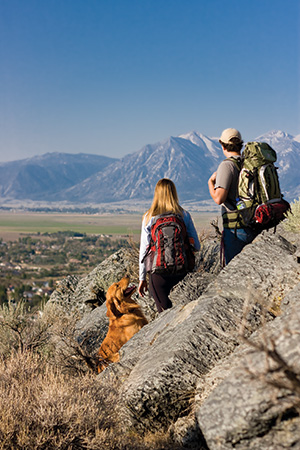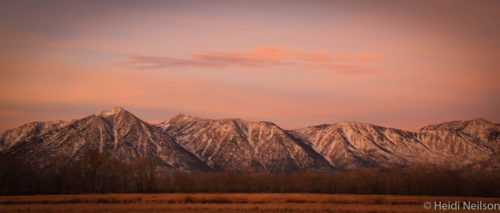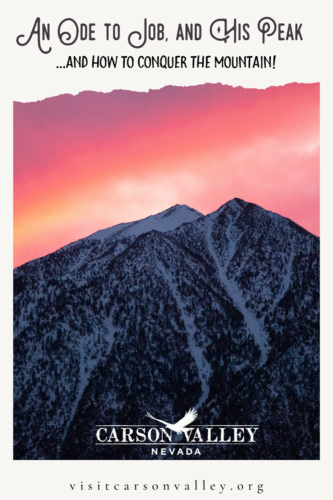 Discover Jobs Peak: Carson Valley’s Iconic Granite Sentinel
Discover Jobs Peak: Carson Valley’s Iconic Granite Sentinel
You can’t visit Carson Valley without being drawn to its most iconic natural landmark — Jobs Peak. Towering at 10,633 feet, Jobs Peak dominates the skyline, standing watch over the valley like a stoic sentinel. Its striking presence makes it one of the most photographed and admired peaks in the eastern Sierra Nevada.
This majestic mountain has long captivated those who pass through. In 1860, observer Henry DeGroot described Jobs Peak as a “naked cone of bleached granite so white that at a distance it is apt to be taken for snow.” And indeed, even in the heat of summer, patches of snow often cling to its slopes, giving Jobs Peak its signature snowcapped look well into the warmer months.
Before going further, let’s clear something up: Jobs Peak is pronounced like “Job” from the Bible, not like Steve Jobs of Apple fame. And while the name originally included an apostrophe — Job’s Peak — it has since lost it to history. Interestingly, though Jobs Peak is located in Alpine County, California, it is best viewed from Douglas County, Nevada, making it a unique bi-state wonder.
Jobs Peak and Its Notable Neighbors
Jobs Peak is part of the Carson Range, a subrange of the Sierra Nevada. It forms a stunning trio with nearby Freel Peak (the tallest in the area) and Jobs Sister, a neighboring summit with a quirky name that honors the family ties of the mountain’s namesake.
The Man Behind the Mountain
So where did Jobs Peak get its name? In 1854, Moses Job, an early Mormon settler, opened a store at the base of the mountain near what is now Sheridan, Nevada. The store sparked the growth of a small community, and its popularity helped establish Job’s name in local history — apostrophe included.
According to “Carson Valley: Historical Sketches of Nevada’s First Settlement,” Moses Job once climbed the peak himself and planted an American flag at the summit, proclaiming it would bear his name. The 1855 State Surveyor General Report referred to the region as “Job’s Group of Mountains,” and later maps adopted the names Jobs Peak, Jobs Sister, and Freel Peak, securing their legacy in local lore.
Can I hike Jobs Peak?
 If you have a spirit for adventure like Job did, the answer to this often-asked question is, yes, you sure can. However, there are some key things to know before you lace up your boots. It is a misnomer that you can access Jobs Peak via the Faye Luther or Jobs Peak Ranch Trailhead. These trails, both awesome in and of their own, don’t provide a trail to the peak. The best way to conquer Jobs is to basecamp in Carson Valley (either Minden, Genoa or Gardnerville) and get a jump on the day. You can check out where to stay here. You’ll then want to take the beautiful drive up Highway 88 into Hope Valley, before taking a right (north) at Pickett’s Junction onto Luther Pass Rd (Hwy 89). Keep an eye out, because you will want to turn right onto Forest Service Road 051 (also known as Willow Creek) before you reach Luther Pass. This road is dirt and rugged, so be sure to have the appropriate 4×4 vehicle. There is a big open dirt area for parking about 3.5 miles in for Freel Peak, but if you keep going roughly 3 more miles you will be able to hit the trail and start your ascent up Jobs. The trail is primitive and about 2 miles long with 2,000 feet elevation gain.
If you have a spirit for adventure like Job did, the answer to this often-asked question is, yes, you sure can. However, there are some key things to know before you lace up your boots. It is a misnomer that you can access Jobs Peak via the Faye Luther or Jobs Peak Ranch Trailhead. These trails, both awesome in and of their own, don’t provide a trail to the peak. The best way to conquer Jobs is to basecamp in Carson Valley (either Minden, Genoa or Gardnerville) and get a jump on the day. You can check out where to stay here. You’ll then want to take the beautiful drive up Highway 88 into Hope Valley, before taking a right (north) at Pickett’s Junction onto Luther Pass Rd (Hwy 89). Keep an eye out, because you will want to turn right onto Forest Service Road 051 (also known as Willow Creek) before you reach Luther Pass. This road is dirt and rugged, so be sure to have the appropriate 4×4 vehicle. There is a big open dirt area for parking about 3.5 miles in for Freel Peak, but if you keep going roughly 3 more miles you will be able to hit the trail and start your ascent up Jobs. The trail is primitive and about 2 miles long with 2,000 feet elevation gain.
Important: Be sure to check with the Humboldt-Toiyabe National Forest’s Carson Ranger District before you go, as the gate to the 051 road can be closed during different times of the year due to conditions. Their contact is (775) 882-2766.
Once you’ve summitted Jobs, you have the option to hit the triple crown and bag the other two peaks (Freel and Jobs Sister), or head on back to Carson Valley where there are many beverage and dining options to celebrate your day of backcountry bliss.

A few more crucial tips:
- Adhere to leave no trace principles.
- Be sure someone knows where you are and when you plan to return.
- No special permit is required and dogs are welcome, but be sure to keep them on a leash.
- The best time to visit is June – October, weather dependent.
- Trekking poles are advised due to decomposed granite.
- Give yourself plenty of time.
- Bring water with you.
- Weather can change suddenly, so be prepared and watch signs for thunderstorm activity.
- Some people can feel the effects of altitude sickness even before reaching the top. Make sure to pay attention to the signs: headache, dizziness, among others.
It is hard not to love Jobs Peak for its beauty, history, and even its endearing missing apostrophe. Whether you prefer to amble its summit or simply enjoy the view from the valley below, Jobs is everyone’s favorite friend in Carson Valley.
Be sure to follow us on Facebook and Instagram and use the hashtag #WhyCV (as in, why you love Carson Valley—for many, it’s this mountain!) in your Jobs Peak photos!
Photos courtesy of Visit Carson Valley.




